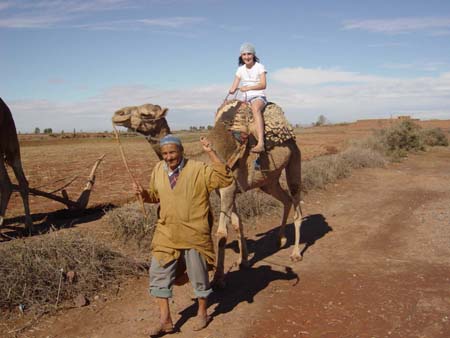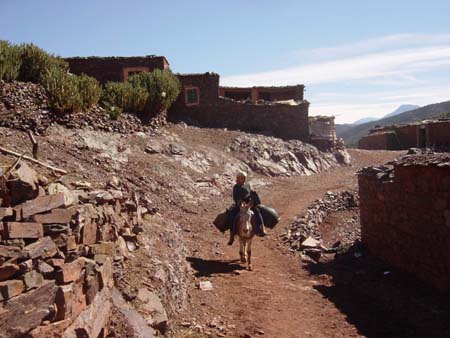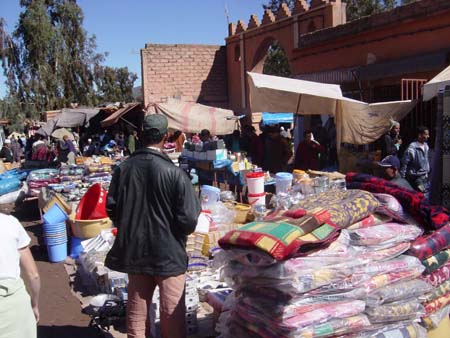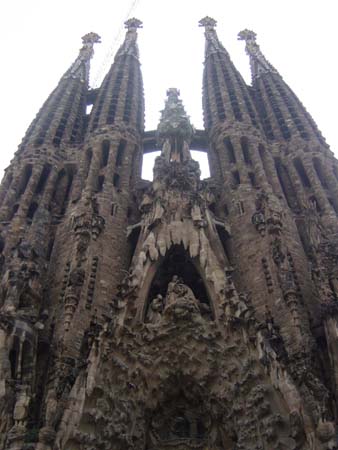Saturday, October 25
Steve: We were very happy to see blue skies this morning for our excursion into the Atlas Mountains. With the rain and clouds of the past couple days, it hasn't even been possible to see the mountains from the streets of Marrakech. By 9:30 we were ready to go, and our driver (in the standard large yellow Mercedes) met us at the hotel.
 Almost
immediately, we were able to see the snow-capped mountains as we drove along
Boulevard Casablanca (one of the main streets here). The mountains appear
very majestic in the distance, and we understand that snow is visible year-round.
We imagine that this must be a very unusual sight during the summer when the
temperature is often well into the 100's.
Almost
immediately, we were able to see the snow-capped mountains as we drove along
Boulevard Casablanca (one of the main streets here). The mountains appear
very majestic in the distance, and we understand that snow is visible year-round.
We imagine that this must be a very unusual sight during the summer when the
temperature is often well into the 100's. 
It only takes 10 minutes to leave the confines of Marrakech, and we quickly
were driving along a straight road that cut into the surrounding cactus-filled
plains and toward the mountains. The area around Marrakech is all very flat,
and the mountains appear to rise very abruptly. Spread intermittently across
the plains we saw small villages, markets, schools and government buildings.
We also saw many people walking or riding donkeys along the road, often carrying
goods that they had bought or were planning to sell at the local markets.
The people who live out here clearly don't have easy lives - they have to
travel fairly large distances for basic needs, and in the heat of the summers
this must be very difficult.
We made several stops on our way into the mountains, including one where
we saw a man plowing his fields with camels. The man was very friendly, and
allowed us to take pictures and offered to let David and Katie ride the camels.
At one point in our planning for this trip, we had thought about taking a
multiple-day camel trek. The kids were disappointed when this didn't  work
out, and we promised that they'd be able to ride a camel at some point. So
today we fulfilled that promise! Katie absolutely loved being on the camel
and swears that she could stay up there for hours - we're not so sure…
After the rides we gave the man a 20 Dirhan bill (about $2), but he didn't
want to take it. We insisted that he keep it, and thanked him for sharing
his camels with us.
work
out, and we promised that they'd be able to ride a camel at some point. So
today we fulfilled that promise! Katie absolutely loved being on the camel
and swears that she could stay up there for hours - we're not so sure…
After the rides we gave the man a 20 Dirhan bill (about $2), but he didn't
want to take it. We insisted that he keep it, and thanked him for sharing
his camels with us.

We also stopped to photograph several small hillside villages. The way that
they blend into the surrounding mountains is very beautiful. Again, it's a
law that all buildings are painted the ochre color that matches the soil,
and the resulting effect is that the villages appear very natural and peaceful.
We also saw several schools with children playing in the courtyards. Several
of these schools appear to be located far away from the surrounding villages,
and we were told that many of the children have very long walks to make each
day.
It was possible to see the irrigation canals that have been built from the mountains leading to the villages below. A series of dams have been put in place, and despite the dry season, it appeared to us that the canals still had ample supplies of water. Several of the streams in the valleys are clearly drying out, though, and there are many concerns here about water supplies for the future.

As we drove further, the scenery became more striking. The combination of
deep valleys, multi-colored hills, and the snow-capped mountains is lovely.
As the roads narrowed and became very windy, our driver stopped and offered
to let us walk up a hill toward a very small village. This turned out to be
a really wonderful experience. Only 160 people live in this village, and there's
no running water or electricity. Water is brought up from the nearby mountain
streams by donkeys, and  batteries
are used for power. We asked our driver about telephones, and were amused
to learn that there is no public telephone service but that everyone has cell
phones.
batteries
are used for power. We asked our driver about telephones, and were amused
to learn that there is no public telephone service but that everyone has cell
phones.
 When
we reached the top of the hill, we were able to see the entire village and
had great panoramic views to the surrounding mountains. The people who live
here are Berbers - the word "Berbers" originated from "barbarians",
and this is a culture distinct from the Arabs that live in Marrakech. The
Berber language is very different from Arabic, but the schools here teach
both.
When
we reached the top of the hill, we were able to see the entire village and
had great panoramic views to the surrounding mountains. The people who live
here are Berbers - the word "Berbers" originated from "barbarians",
and this is a culture distinct from the Arabs that live in Marrakech. The
Berber language is very different from Arabic, but the schools here teach
both.
While the homes here are very small, each one has its requisite hammam (bath)
- the smoke from the fires that heat the water was emanating from each residence
(it's clearly visible in this picture). It's amazing to us that even in such
a small and remote village, the hammams are considered to be a necessity.
We were approached and followed by a group of small children who were asking for Dirhans from us in French. They kept saying,"Monsieur, Monsieur, Dirhans?" The children were very friendly and enjoyed interacting with David and Katie. We gave them the coins that we had, each child smiling broadly and showing off their prizes to their friends and family. We felt bad when we ran out of coins (since we were now being followed by more and more children), and eventually worked out an arrangement with our driver. We gave him a 20 Dirhan bill, and asked him to explain to the children that they needed to share this fairly among them. In return, we'd get to take a photo of the group of them with David and Katie. This was perfect! The children all ran away literally laughing with delight, and we got a wonderful picture.

From the village, it is possible to see two separate streams running on opposite
sides of the hill. The first stream is for washing, and we saw several women
with large bundles of clothes that they were cleaning in the running water.
They use donkeys to carry the clothes up and down the hills. The second stream
is for drinking water, which again is delivered on donkeys. We passed a girl
in the village who was riding a donkey and delivering water to this village
and others.
Our next stop was the colorful and very lively Berber market in Asni. Each
village has a market on a different day of the week, and the market in Asni
had been highly recommended to us. We were not disappointed - this was definitely
the most active and interesting market we've seen on our entire trip and was
a wonderful experience. People  come
here on donkeys (and a few stuff themselves into cars - we counted 10 people
in one small car) from villages all over the region. They come here to buy
almost anything, including food, clothing, and things for their homes. Everything
is negotiated, often very loudly.
come
here on donkeys (and a few stuff themselves into cars - we counted 10 people
in one small car) from villages all over the region. They come here to buy
almost anything, including food, clothing, and things for their homes. Everything
is negotiated, often very loudly. 
There is a huge variety of food that is sold and prepared in the market.
The smells and colors of all the fruits, vegetables, herbs, meats, live birds
and rabbits is something we'll never forget. Many of these foods were not
recognizable to us, and our driver tried to explain to us what we were seeing.
 Sometimes
he didn't know the English description of specific foods, so we simply had
to guess at what they were. Again, much to Katie's dismay, we had to be careful
where we walked so as to avoid the sheep heads that were arranged on the ground
(they're in this picture on the left). Yuck.
Sometimes
he didn't know the English description of specific foods, so we simply had
to guess at what they were. Again, much to Katie's dismay, we had to be careful
where we walked so as to avoid the sheep heads that were arranged on the ground
(they're in this picture on the left). Yuck.
We saw a "donkey dealership" (our words) where we saw donkeys being groomed and sold. Nearby we saw people repairing and selling saddles and a variety of other accessories for the donkeys. Of course, the market has its requisite "donkey parking lot" (pictured here), where for 1 Dirhan you can leave your donkey while you shop. Sometimes the donkeys became agitated and began "hee-hawing" very loudly - to us this was entertaining, but it seemed like on one else could even hear it.
 This
market also offered the services of bakers (where you bring your own dough
in to be baked), barbers, and even a doctor and a dentist. We saw several
men being shaved and having their hair cut, right in the middle of all the
activity. We also saw a dentist's office (it's pictured on the left and is
simply a small cement room with a curtain). There were a couple of women wearing
pained expressions and waiting to get in, and we were told that behind the
curtain were two men with a pair of pliers who pull decaying teeth. We cringed
at the thought, and this made us wonder about the quality of the medical care
available to the people here. We
This
market also offered the services of bakers (where you bring your own dough
in to be baked), barbers, and even a doctor and a dentist. We saw several
men being shaved and having their hair cut, right in the middle of all the
activity. We also saw a dentist's office (it's pictured on the left and is
simply a small cement room with a curtain). There were a couple of women wearing
pained expressions and waiting to get in, and we were told that behind the
curtain were two men with a pair of pliers who pull decaying teeth. We cringed
at the thought, and this made us wonder about the quality of the medical care
available to the people here. We  have
noticed that most people, although certainly living with only the basic essentials,
appear to be generally healthy.
have
noticed that most people, although certainly living with only the basic essentials,
appear to be generally healthy.
We enjoyed peeking into some of the tiny restaurants along the side of the
market. The smoke and smells from the men cooking kebabs on small grills whet
our appetites. We saw many people cramped together, drinking tea and eating
 on
the floor.
on
the floor.
Behind the market is a wonderfully scenic stream and bridge, with great views
of the mountains behind. People come here to wash, to let their donkeys drink,
and to take rests from the activities of the market. There was also a bridge
where we saw donkeys from other villages entering the market to gather supplies.
We stopped to take in the view and watch a man bathing in the stream (he's
pictured below on the left), using the rocks to scrape his skin clean. 
While we were the only tourists that we saw in the market today, people again
were friendly, and we did not at any time feel unwelcome, overly pressured
or hassled. We again felt like we were  on
the set of a movie where we didn't belong, yet our presence was accepted.
This made for a very rich and educational experience for us all, and for memories
that will not be forgotten.
on
the set of a movie where we didn't belong, yet our presence was accepted.
This made for a very rich and educational experience for us all, and for memories
that will not be forgotten. 
From Asni we drove to Ouirgane, located another 12 kilometers further into the mountains. Here we stopped at a luxury resort called La Roseraie for lunch and a walk through the extensive gardens. This is a quiet, 5-star resort situated beautifully in a valley. After a great lunch of mixed grilled Moroccan meats and vegetables, we took a walk with our driver through the property. There are long trails here that took us by all kinds of fruit trees (including orange, lemon, grapefruit and almond), wonderful herb gardens, and secluded villas belonging to the property. While we were walking, we encountered these women in traditional Berber dress carrying grass that they had collected as feed for the donkeys.
This is not high season for tourism in Morocco and the resort seemed very empty - we were assured that starting in January it will fill up (high tourist season runs from January through April).
 The
drive back to Marrakech was uneventful, and took about 90 minutes. As we passed
by Asni, we saw many people riding their donkeys loaded with all the goods
they had purchased. Apparently they had spent much of their afternoons at
the market, and were now returning to their villages. It's amazing how much
weight the donkeys can carry, and their riders seem to hit them indiscriminately.
Some of the donkeys are extremely small, and we feel sorry for them.
The
drive back to Marrakech was uneventful, and took about 90 minutes. As we passed
by Asni, we saw many people riding their donkeys loaded with all the goods
they had purchased. Apparently they had spent much of their afternoons at
the market, and were now returning to their villages. It's amazing how much
weight the donkeys can carry, and their riders seem to hit them indiscriminately.
Some of the donkeys are extremely small, and we feel sorry for them.
This evening we had the pleasure of spending a few hours with Judy and Richard Flaherty. Judy and Richard moved to Marrakech three years ago (after having visited here on more than ten occasions), and are two of only a couple hundred Americans who reside here. Judy teaches reading at the American School of Marrakech, and Richard has retired from his career as a social worker.
It was very interesting and educational to hear Judy and Richard's perspectives
on the country of Morocco, and specifically life here in Marrakech. We learned
that the unemployment problem is far worse than what we've read, and that
the number of tourists is dangerously low. There is no real industry here,
and several companies that were located in Morocco have left because the wages
were too expensive. It's not clear to Judy and Richard what the country will
do to increase the number of jobs, but this is definitely the biggest problem
here today.
Despite the issues surrounding September 11 and the war in Iraq, Judy and Richard indicated that they've never felt unsafe or unwelcome here. They said that occasionally they've sensed an undercurrent of negative feelings toward foreigners, but that this is unusual. The bombing last May in Casablanca has everyone here concerned, and extra security measures have been put in place (including at the school where Judy works).
Interestingly, there is no local newspaper in Marrakech, so Judy and Richard weren't able to answer our questions regarding local politics or crime. This information simply is not made available to the public, and news is spread mainly by word of mouth. For a city of 1.5 million people, this seemed very unusual to us.
Judy and Richard confirmed that other religions are tolerated, but that since
they're so small in size (the population is well over 99% Muslim), this is
not really a meaningful issue. We mentioned that our guides have all explicitly
pointed out this religious tolerance to us. Judy and Richard said that this
is consistent with what they've observed here also. They also told us that
they believe the Muslims here are genuinely concerned about maintaining good
relations with the West, and particularly the U.S. Judy noted that Americans
are one of the only nationalities able to get long-term  visas
for working in Morocco. This option is not available to Europeans.
visas
for working in Morocco. This option is not available to Europeans.
Environmental protection is not a major focus in Morocco, and we have noticed that in several areas of the city the air smells of pollution. Judy said that people are not educated about the need to protect the environment, and she is specifically trying to teach her students about environmental issues.
After a light dinner with Judy and Richard, we walked into a local bakery to see (and buy some samples) of the pastries that have been prepared for Ramadan. We then walked back to our hotel feeling very tired, but excited about all we had experienced today. Tomorrow we plan to walk through the newer part of Marrakech, and perhaps visit some of the gardens here.
Distance Walked: 1.83 miles
KATIE'S KOMMENTS
NOTE FROM THE EDITORS: Katie wants it made clear that this edition of Katie's Komments was actually written several days ago. However, due to unnecessary delays by the technical staff, this entry was not posted until today. The staff apologizes for this inconvenience, and sincerely hopes that the delay does not detract from your reading enjoyment. Thank you for your understanding.
October 25 - The topic for today is…the modernistic style of Gaudi
in Barcelona
You turn the corner and look up at the famous La Sagrada Familia. It is incredible.
The enormous church with its ingenious design and tall spires was created
by the architect Gaudi. You walk closer to the front of the church and become
even more astounded. The front nave is completely engraved with thousands
of designs and curves giving it a drip-castle-like effect. You cannot identify
a single straight line in the complicated and stirring architecture. It has
curves, engravings, decorations, ornamental drip shapes and wondrous artistic
features that give it a strong sense of energy and dimension. You notice how
many of these designs involve elements of nature such as plant life and cave
forms. You wonder how anyone could have ever created this marvelous structure.
You gaze at the nave in amazement…this is only one side of the entire
cathedral and after 100 years of work to live on Gaudi's dream, the planned
20 spire cathedral is less than halfway complete. Gaudi had a dream, a different
kind of dream.
Gaudi was one of many architects who practiced Modernisme in their architecture.
This new style of architecture had different names throughout Europe. The
British and French called it Art Nouveau, the Italians called it lo stile
Liberty, and to the Germans it was Jugendstil (Youth style). Regardless of
the name, this unique style of architecture had the same objective. The aim
of this unusual technique was to create an original style for the Modern age.
This method involved using aspects of nature and fantasy to create a gracefu l,
and in some cases energetic structure. There was an approach of expressiveness
and curvature in the architecture, rather than the usual form of mathematical
structure. This allowed much playfulness and creativity to be carved into
the architecture. Barcelona, home of the inspirational architecture of Gaudi,
was one of three centers of this modernistic style. The architecture by Gaudi
in Barcelona includes the Sagrada Familia, Parc Guell, and numerous homes
and apartment buildings hidden in the packed buildings of the large city.
l,
and in some cases energetic structure. There was an approach of expressiveness
and curvature in the architecture, rather than the usual form of mathematical
structure. This allowed much playfulness and creativity to be carved into
the architecture. Barcelona, home of the inspirational architecture of Gaudi,
was one of three centers of this modernistic style. The architecture by Gaudi
in Barcelona includes the Sagrada Familia, Parc Guell, and numerous homes
and apartment buildings hidden in the packed buildings of the large city.
All in all, Gaudi's modernistic style of architecture in Barcelona made
the city a very interesting and different place for us. The Sagrada Familia
broke the mold of typical Gothic churches that we have seen in Europe by going
a little "over the top." The colorful Parc Guell with its fountains,
benches and houses made from fragments of decorative tiles, added a fantasy
element to Gaudi's architecture. This unique style of artistic expressiveness,
movement, and energy added liveliness and character to the entire city of
Barcelona.
